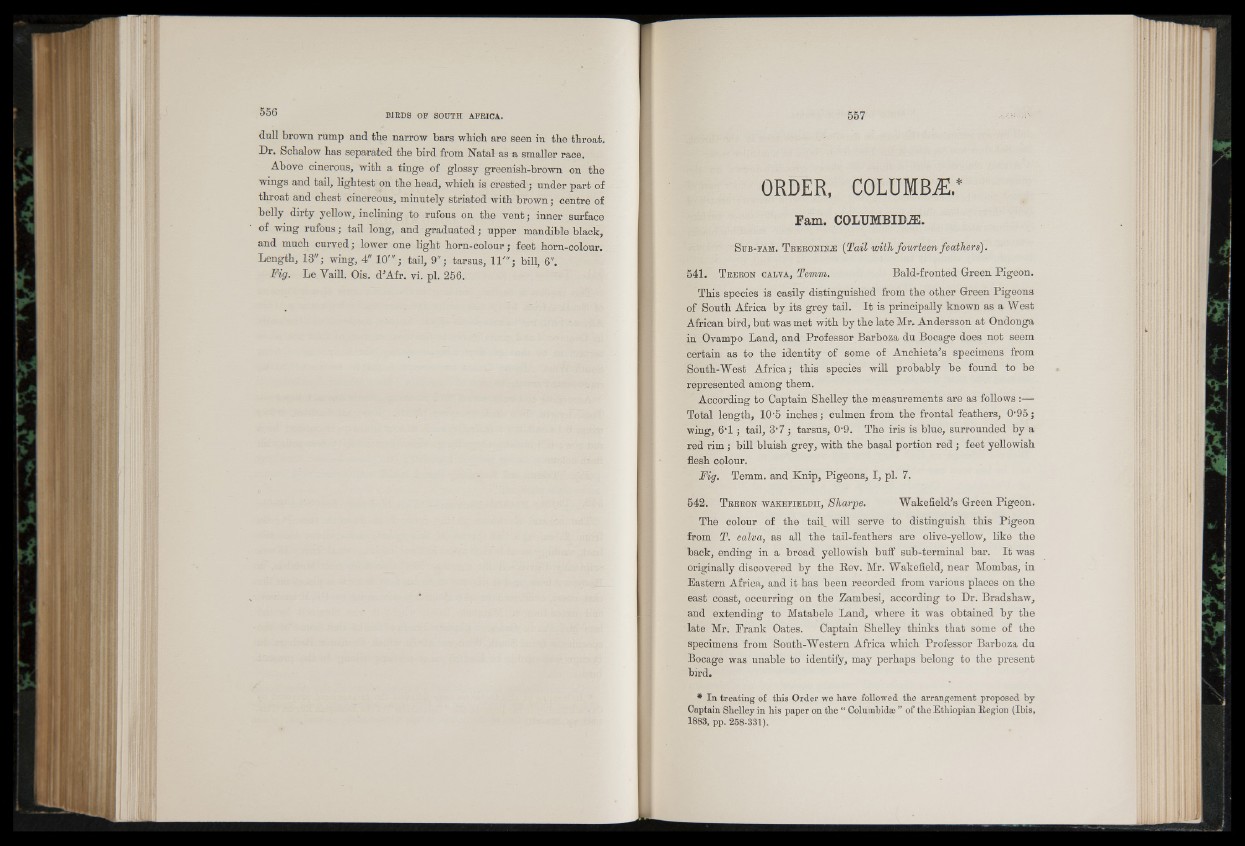
dull brown rump and the narrow bars which are seen in the throat.
Dr. Schalow has separated the bird from Natal as a smaller race.
Above cinerous, with a tinge of glossy greenish-brown on the
wings and tail, lightest on the head, which is crested; under part of
throat and chest cinereous, minutely striated with brown; centre of
belly dirty yellow, inclining to rufous on the vent; inner surface
of wing rufous; tail long, and graduated; upper mandible black,
and much curved; lower one light horn-colour; feet horn-colour.
Length, 13"; wing, 4" 10'"; tail, 9"; tarsus, 11'"; bill, 6".
Fig. Le Vaill. Ois. d'Afr. vi. pi. 256.
ORDER, COLUMBA!.’
Fam. COLUMBIM.
S ub-fam. T r er o n in .e {Tail with fourteen feathers).
541. T reron calva, Temm. Bald-fronted Green Pigeon.
This species is easily distinguished from the other Green Pigeons
of South Africa by its grey tail. It is principally known as a West
African bird, but was met with by the late Mr. Andersson at Ondonga
in Ovampo Land, and Professor Barboza du Bocage does not seem
certain as to the identity of some of Anchieta's specimens from
South-West Africa; this species will probably be found to be
represented among them.
According to Captain Shelley the measurements are as follows :—
Total length, 10-5 inches; culmen from the frontal feathers, 0‘95;
w i n g , 6T ; tail, 3‘7 ; tarsus, 09. The iris is blue, surrounded by a
red rim ; bill bluish grey, with the basal portion red ; feet yellowish
flesh colour.
Fig. Temm. and Knip, Pigeons, I, pi. 7.
542. T rero n w a k e f ie ld ii, Sharpe. Wakefield's Green Pigeon.
The colour of the tail will serve to distinguish this Pigeon
from T. calva, as all the tail-feathers are olive-yellow, like the
back, ending in a broad yellowish buff sub-terminal bar. It was
originally discovered by the Rev. Mr. Wakefield, near Mombas, in
Eastern Africa, and it has been recorded from various places on the
east coast, occurring on the Zambesi, according to Dr. Bradshaw,
and extending to Matabele Land, where it was obtained by the
late Mr. Frank Oates. Captain Shelley thinks that some of the
specimens from South-Western Africa which Professor Barboza du
Bocage was unable to identify, may perhaps belong to the present
bird.
* In treating of this Order we have followed the arrangement proposed by
Captain Shelley in his paper on the “ Coluinbidas ” of the Ethiopian Region (Ibis,
1 8 8 3 , p p . 2 5 8 -3 3 1 ) .